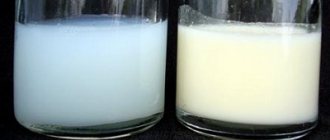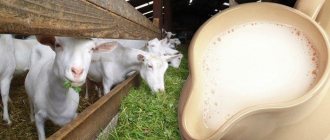Every mother wants her child to grow up completely healthy and actively develop in all directions.
Women are especially worried about this during lactation, and therefore quite often they have a lot of questions about their diet, for example, can a nursing mother have porridge with milk. Such food is usually considered by nutritionists to be healthy and extremely useful, but are these qualities preserved when it comes to a mother’s nutrition during breastfeeding and can it in any way harm the health of the baby?
Rules for eating porridge during lactation
- After childbirth, cereals are cooked in water. Cow's milk protein often causes allergies in infants. A negative reaction can manifest itself as a rash, increased gas production, colic, and rumbling in the tummy.
- Each type of cereal is introduced into the menu gradually, starting with a serving not exceeding 50 g. This rule especially applies to cereals containing gluten, a protein of plant origin with a high degree of allergenicity.
- A mixture of cereals, including different types of cereals, is introduced into the menu when the child is already 6 months old. This combination can lead to digestive upset in the baby. Semolina is also a cereal that causes undesirable reactions.
- If the baby has a tendency to constipation, the nursing mother needs to limit the consumption of rice, and, conversely, include it in the menu if bowel movements are too frequent.
- Barley can cause increased gas formation in infants.
- It is better to replace plain butter with melted butter during breastfeeding. After heat treatment, this product is better absorbed and less likely to cause allergic reactions.
- During the first 1-3 months after childbirth, it is useful to eat cereals with baked apples and pears. By the 4th month, you can add dried fruits and bananas to the dish.
- Too sweet cereals during breastfeeding cause fermentation in the intestines of the mother and child. For this reason, you should not add a lot of sugar or raisins to them.
- Sensitivity to a particular product is often inherited. This feature should be taken into account when choosing cereals. If a nursing woman experienced discomfort after eating any cereal before giving birth, you should not eat it, even if it is very healthy. There are many grains - you can always find a worthy replacement.
If rashes appear on the child’s skin after eating porridge, problems with digestion, or an inappropriate dish are excluded for a while. After some time, the introduction of the product is repeated.
When to include porridge in the menu of a nursing mother
In the first month after birth, the diet recommended by the World Health Organization (WHO) excludes fresh vegetables and fruits. But cereals contain a lot of fiber, so they must be included in the daily diet. Porridge normalizes intestinal motor function, improves digestion, and provides energy. A nursing mother can consume all cereals if there are no contraindications.
Immediately after childbirth, it is allowed to eat buckwheat, barley, rice, and wheat cereals. The grains must be well boiled. Finely ground wheat groats are chosen - the Artek variety. Add a little vegetable oil to the dish. The porridge is lightly salted. No sugar is added.
From the second week, corn, millet, and pearl barley are added to the menu. The consumption of semolina, flaxseed, barley, and pea porridge is usually excluded in the first 6 months of lactation. Nutritionists consider these cereals difficult to digest, but from the observations of breastfeeding consultants it follows that bad reactions are extremely rare.
How to eat corn porridge correctly
Cereals during breastfeeding should be introduced in stages. First try eating a few spoons and observe the reaction for 2-3 days. If the latter is missing, you can continue.
For the first 3-4 months, consume water-based corn porridge; cow's milk is an allergen; in subsequent months, increase the proportion of milk. You can add soy or goat.
Not every child is able to accept this particular type of cereal. This depends on the characteristics of metabolism and heredity. If an allergy occurs, the stool changes (it becomes too thin or thick, the color changes), colic appears, you must not eat corn porridge for a month, and then try again.
If you have constipation, you should limit the use of this product due to the high starch content. You need to monitor your child's stool.
There are certain cooking rules. Consumption of fried soups is not allowed. You should also not overuse the quantity, as this can cause a feeling of bloating and heaviness in the abdomen.
You should avoid eating fresh corn, but you can always treat yourself to corn sticks or flakes. Fresh corn can cause bloating and colic in your baby. You can start using it from the age of at least 3 months, and increase the amount gradually.
It is strictly forbidden to eat canned food; it contains preservatives. It's not common to eat popcorn.
The main thing is not to overdo it. It is optimal to alternate the different types of dishes that are allowed during this period.
Types of porridges
A woman without chronic diseases can eat all cereals while breastfeeding. Cereals should be introduced into the diet gradually, in small portions. This measure will help avoid unwanted reactions in the baby.
Gluten Free Cereals:
- rice,
- buckwheat,
- millet (millet),
- corn.
These cereals can be eaten if a woman or child does not tolerate this protein well.
Porridges with gluten:
- wheat,
- barley,
- oatmeal/rolled oatmeal,
- semolina,
- pearl barley,
- bulgur,
- spelled
Buckwheat
Cereals contain a lot of useful substances: iron, potassium, magnesium, sulfur, phosphorus, B vitamins, antioxidants. Buckwheat helps after childbirth to cope with anemia caused by a lack of hemoglobin. It is well absorbed. Buckwheat is one of the safest and healthiest grains during lactation, therefore it is allowed from the first days after birth. Please note that it cannot be combined with milk. The fact is that iron is poorly absorbed if combined with foods containing calcium.
Rice porrige
This dish will help get rid of diarrhea and intestinal dysbiosis. Rice has absorbent properties: it absorbs toxins and removes them from the body. The cereal satisfies well and gives energy. Rice is a source of iron, phosphorus, magnesium, B vitamins and other important elements. The consumption of this cereal is limited for constipation, hypertension, and diseases of the cardiovascular system.
Corn porridge
Cereals are rich in biotin (vitamin H), nicotinic acid, and iron. In addition to these nutrients
corn contains rare trace elements such as cobalt, manganese, copper, molybdenum, chromium. These substances support the beauty of a nursing woman, normalize metabolism, and improve digestion.
Corn helps relieve constipation. This cereal increases the secretory activity of gastric juice. For this reason, it is not advisable for mothers with hyperacid gastritis, gastric ulcer, or duodenal ulcer to consume corn dishes.
Oatmeal (rolled oats) porridge
This cereal is useful during lactation because it contains potassium, calcium, sodium, phosphorus, calcium, magnesium, vitamins A, B1, B2, B5, C, E. Antioxidants support immunity after childbirth and improve skin condition. The abundance of sodium in oatmeal helps to cope with apathy, general weakness, and headaches caused by low blood pressure. The dish should not be consumed by women with kidney or heart failure. With these pathologies, excess sodium content in rolled oats will only do harm.
Wheat porridge, bulgur, spelt
These cereals are made from wheat. The processing of the grains is different. This feature affects the chemical composition of the final product. Finely ground wheat groats can be eaten immediately after childbirth. On the product packaging, the manufacturer indicates the Artek variety. This cereal contains a minimum of fiber, because... It is polished during processing.
1-2 months after giving birth, you can switch to Poltavskaya. This variety is marked on packs from No. 1 to No. 4. The higher the number, the coarser the grind. Poltavskaya, numbers 1 and 2, is ideal for preparing this dish.
Wheat porridge is a very healthy dish for a nursing mother. It contains a lot of silicon, calcium, phosphorus, zinc, selenium, molybdenum, and nicotinic acid. Valuable properties of wheat during breastfeeding:
- stimulates the immune system,
- improves skin condition,
- stabilizes the functions of the heart, blood vessels,
- strengthens bones and joints.
The dish is useful for preventing rickets and anemia in a child.
Bulgur is distinguished by coarse grinding of grains. During breastfeeding, it is included in the diet from 2 months.
Spelled is grains of wild wheat. It contains less gluten than regular cereal. In terms of beneficial properties, spelled is superior to wheat groats. It contains a lot of calcium and iron.
Barley porridge
This cereal contains a lot of phosphorus, manganese, copper, chromium, and nicotinic acid. Pearl barley improves peristalsis, envelops the walls of the stomach, protecting them from inflammation. If women do not have chronic diseases of the gastrointestinal tract, it can be consumed from 6 months after childbirth. Barley porridge is a source of dietary fiber. Breastfeeding experts do not recommend introducing pearl barley porridge into the diet early, since it often causes babies to have colic and difficulty passing gas.
Millet porridge
The dish is well digestible. Millet contains nicotinic acid, B vitamins, potassium, magnesium, phosphorus, cobalt, Omega-6 fatty acids. These elements saturate milk with beneficial compounds. Dietary fiber prevents postpartum constipation. Millet should be limited in case of diarrhea and hormonal diseases.
Barley porridge
This cereal, like pearl barley, is made from whole barley. Barley is rich in potassium, iron, and phosphorus. The product is useful, but is poorly absorbed by nursing women. This porridge is introduced into the diet no earlier than 6 months after childbirth.
Barley porridge
Cereals are made from peeled barley grains. A finely ground product is included in the diet to restore the body after childbirth.
Barley, thanks to its valuable composition, has a tonic, strengthening, anti-inflammatory effect. Barley porridge restores hormonal levels.
Cereals are excluded from the menu in case of exacerbation of heart or gastrointestinal diseases. Barley is contraindicated for celiac disease.
Semolina
Cereals are made from wheat. Semolina contains few useful substances. During breastfeeding, it is excluded from the diet until the child is 6 months old. Semolina is a high-calorie product with a high gluten content. This element is poorly absorbed by the baby. In addition, cereal slows down the absorption of vitamin D, which is important for growth and mental development.
What are the benefits of porridge?
What are the benefits of appetizing and tasty cereals when breastfeeding?
- Buckwheat improves lactation and is quickly absorbed; it will help with anemia and obesity, and also improve the structure of teeth, bones, skin and hair.
- Oatmeal will help cope with stress, strengthen the immune system, and cleanse the body, helping to remove toxins and waste.
- Barley is unique in that it completely retains its beneficial components even after cooking. It contains a lot of fiber, which improves digestion; it not only stabilizes stool and stomach function, but also cleanses the body well. The product does not cause allergies, and also helps moms cope with postpartum depression and stress.
- Corn porridge normalizes digestion and helps with constipation and indigestion. It removes toxins and radionuclides, improves the condition of the skin, nails, hair and bones.
- Millet (wheat) cereal is rich in vitamin D, minerals and trace elements. It is recommended for constipation and indigestion, strengthens the immune system and memory, strengthens the heart muscle and improves hematopoiesis.
- Semolina is high in calories and contains a lot of gluten; it can also in some cases cause allergies or damage the walls of the small intestine. But with all this, it also has benefits, as it removes mucus and fat from the body, and is also useful for bones and stomach microflora.
- Rice relieves stress and fatigue by strengthening and restoring nerve cells. It cleanses the body as it is rich in fiber, but it should be used with caution if you are prone to constipation.
Cereals are healthy and nutritious; you can use them to prepare not only porridge, but also all kinds of soups. They will not only help you recover after childbirth, but will also become a source of vitamins, minerals and trace elements necessary for a newborn. In addition, cereals will help women cope with postpartum hemorrhoids, which, according to statistics, affects up to 80% of mothers after childbirth.
At first, women think that the problem will disappear by itself, which is fundamentally wrong. Hemorrhoids are a serious problem that, if left untreated, can lead to bowel cancer. Porridge will help you cope with it, which often becomes the only way of salvation when medications are strictly prohibited, since most of them are incompatible with breastfeeding.
Is it possible to eat pea porridge while breastfeeding?
Legumes cause bloating and excessive gas formation, so consumption of products from this family is not recommended for a nursing woman until 6 months after giving birth. This opinion is shared by most experts. Some pediatricians deny the bad effect of pea porridge on lactation. If a woman tolerates the product well, then the child will also benefit from it. Peas are a source of vegetable protein that has a beneficial effect on the development of the skeletal system.
When to introduce milk porridges
The introduction of porridge into a child's complementary feeding occurs by 5–6 months of age. It is recommended to do this a month after starting to take fruit and vegetable purees.
If complementary feeding is suitable, then they begin dairy-free options - it is optimal to give gluten-free porridge - buckwheat, corn, rice. Such compositions do not cause allergies. Then they give cereals with gluten - oatmeal, millet, semolina.
They try to eat dairy porridges after the successful introduction of dairy-free ones.
Pediatricians may prescribe early introduction of milk porridges as first complementary foods in the following situations:
- little breast milk;
- the child is gaining little weight;
- there is a lack of B vitamins;
- It is impossible to feed your baby formula or breast milk.
How to cook porridge
Instant cereals lose some of their beneficial properties during industrial processing. It is best to choose a product with a regular cooking time. Large grains (buckwheat, rice, millet) are pre-washed in water and the husks are removed. Salt and sugar are added at the beginning of cooking.
Porridge on the water
- Buckwheat grain. To get a boiled porridge, pour 50 g of the product into 300 ml of cold water. After boiling, reduce the heat to low and leave the buckwheat on the stove for 15-20 minutes.
- Oatmeal. Half a glass of oatmeal is poured into a glass of boiling water. The porridge is stirred periodically. Cooking time depends on the degree of processing of the cereal. Regular rolled oats take 15-20 minutes to prepare. Then turn off the stove and leave to simmer for 5 minutes.
- In order for the barley to cook, you need to soak it for 30-40 minutes. The cereal is added to boiling water - ratio 1:4. You can add water during cooking. Cooking time 40-45 minutes.
- Rice is cooked for about half an hour in a 1:3 ratio. For a viscous consistency of the dish, choose round grains.
- The corn is overcooked. Initial proportions 1:3. Water is added during the cooking process. Corn grits are simmered over low heat for 40-50 minutes.
- Barley is prepared in a ratio of 1:3 for an hour. The cereal is pre-soaked and put in the refrigerator.
- Depending on the grinding, wheat is cooked for 30-50 minutes. For 2 glasses of water you will need 1 tbsp of cereal.
- Millet is boiled in water at a ratio of 1:3. Cooking time – 20-30 minutes.
It is convenient to cook porridge in a slow cooker with a special mode. Once ready, you can add butter or vegetable oil, dried fruits, pumpkin, banana. These components will add nutritional value and beneficial properties to the dish.
Cooking rules
How to cook cereals with water and milk porridges? How to prepare them in such a way as to preserve the maximum amount of nutrients and breastfeeding brings the maximum benefit to the baby? It's simple, just listen to our recommendations:
- The cereals are first sorted, removing debris and foreign inclusions, then washed, poured with water or milk and put on fire. What additives are allowed to flavor the dish? Add just a little bit of sugar and salt, but it’s better not to add them at all. A few minutes before it's ready, you can add a little butter.
- Dried fruits would be an excellent addition to porridge: dried apricots, prunes, dates, etc. They contain a storehouse of vitamins and microelements, in addition, they normalize digestion and stool. The only issue is individual intolerance to the ingredients. Depending on the season, you can add banana or apple, pears, peach and other fruits to the dish.
- Is it possible to cook porridge with vegetables? This is acceptable, but it’s better to start with zucchini and pumpkin. They are hypoallergenic and healthy, in addition, they can be purchased in supermarkets all year round.
- Delicious instant porridges are made in a slow cooker. First add dried fruits and vegetables, cut into slices. Then add cereal and a little butter, add water on top, but enough so that it covers the contents by two fingers. The dish can be cooked.
By the way, during breastfeeding it is not necessary to eat porridge in its pure form; cereals can be added to soups, which are also useful and necessary for the body.
Variety of rice
Rice is divided into three types depending on the length of the grain, but the usefulness is more influenced not by the appearance, but by the type of cereal. Long grain does not stick together when cooked because it absorbs little water. Dishes made from it turn out crumbly. Medium grain rice has grains that are more rounded and less transparent. When cooked, it takes up a lot of liquid, and when finished it is sticky, but does not stick together. Round, short, almost opaque grains are characteristic of short grain rice. It is a champion in starch content. It can be boiled until creamy. It is from this grain that an ideal rice milk porridge is obtained, suitable for feeding children, the sick, as well as women who are breastfeeding.
Rice processing methods:
- unpolished with preserved bran shell;
- polished - a refined product without husks;
- steamed - soaked in boiling water and treated with steam.
Rice varieties: table
| Variety | Characteristic | Dish |
| Basmati | Elite Indian variety with a nutty smell and taste | Pilaf and risotto |
| Jasmine | White rice with a pleasant jasmine scent is grown in Thailand. Does not get overcooked, turns out tender and soft | Salads and side dishes, desserts |
| Red rice | This nutritious and healthy variety does not become overcooked and acquires a nutty aroma after cooking. | Salads, pilaf |
| Wild rice | Long black grains contain the maximum amount of vitamins among rice varieties. Due to its hardness, it requires pre-soaking and long cooking (30–60 minutes) | Soups, salads and appetizers, pie fillings and desserts |
| Black Tibetan rice | The expensive variety, with a beet-purple hue, contains a large amount of protein and cooks for about 40 minutes. | Side dishes and salads |
| Arborio | Medium-grain rice from Italy with a creamy consistency absorbs the taste and aroma of every ingredient in the dish. | Soups and risotto |
| Camolino | Round and large grains from Egypt of pearl-cream color. The variety is treated with vegetable oil. Retains stickiness and softness, but does not stick together | Sushi, desserts, cereals |
| Spanish rice | Small, medium-length grains absorb liquid well and do not stick together during cooking. | Pilaf |
| Krasnodar rice | A universal, inexpensive round-grain variety with the classic aroma and taste of rice | Soups and cereals, puddings, sushi |
| Uzbek rice | Thick and heavy grains absorb large amounts of fat and liquid, which makes the rice crumbly and sweetish. | Pilaf |
Inclusion in a child's diet
This question worries parents just as it does during lactation. But in this case everything is much simpler. Well-cooked rice or rice broth is an excellent complementary food. Rice is easily digestible by the baby and also contains many vitamins and beneficial elements. Doctors recommend starting complementary feeding for your baby with rice porridge .
Age of introduction to complementary foods
The World Health Organization recommends starting complementary feeding from the 6th month of life if the baby is gaining weight well. But before, complementary foods were introduced earlier, so opinions differ. It is better to consult a pediatrician about introducing rice cereal into your child’s diet.
Complementary feeding from 4 months is recommended for children who are not gaining weight well or for children on artificial nutrition. For those who gain weight well, familiarity with adult food begins at 6-7 months of age.
Attention! Before introducing rice into complementary foods, consult your doctor.
In any form?
For a child of the first year of life, it is advisable to consume rice in the form of porridge with water, with breast (goat or cow) milk, or diluted with a mixture. There are instant rice porridges on sale ; they are in no way inferior in health to regular rice porridge. When purchasing, carefully read the instructions, composition and age limits.
Recipe for rice porridge for complementary feeding:
- Rice needs to be washed with plenty of water.
- It is advisable to grind the rice with a blender or coffee grinder. If this is not possible, then after cooking, puree the porridge.
- Pour in warm water and leave for 20 minutes.
- Rice is cooked in a 1/2 ratio (1 cup rice to 2 cups milk or water).
- Add rice to boiling water (milk) and cook for 30 minutes.
For the first time, the child needs to be given a teaspoon of porridge , monitor the reaction and subsequently increase the volume to 150 grams. To get enough nutrients, your child should eat porridge twice a week.
We invite you to watch a video on how to prepare rice porridge for your baby's complementary foods:
Benefits for the baby
- Rice porridge is easily digestible.
- Full of vitamins.
- Its properties have a positive effect on hair and nail growth, the functioning of the nervous system, mental development and immunity.
- Carbohydrates help the small body accumulate energy and activate the brain.
- Rice normalizes the functioning of the stomach and kidneys and removes toxins from the body.
Millet: types, chemical composition and properties
Millet is a millet processing product
Millet is a product of processing the millet cereal crop. Millet grain is actively used for preparing porridges and soups and is a valuable dietary product because it does not contain gluten.
Types of millet
Depending on the method of millet processing, different types of millet are obtained.
Millet dranets is distinguished by its shine and grayish color. It is obtained by cleaning millet grains from flower films while preserving the embryo. This millet retains a maximum of fiber, vitamins and minerals. However, the fats contained in the germ, when oxidized, give the cereal bitterness, greatly reducing its shelf life. To remove bitterness, millet must be washed in cold water, changing it 3–5 times.
The porridge from such cereals turns out to be crumbly, so it is better to use dranets as a side dish.
Polished millet is bright in color and rough to the touch. For its production, millet is cleaned not only from flower films, but also partially from the embryo, seed and fruit membranes. This type of cereal is the most popular on grocery store shelves.
Depending on the duration of cooking and the amount of liquid, polished millet can produce both crumbly and viscous porridge.
Crushed millet is the result of strong grinding of grains; there are relatively few useful microelements. This type of cereal boils very quickly and strongly - ideal for making meatballs and viscous porridges.
Chemical composition and nutritional value of millet
Composition of millet nutrients per 100 grams of dry cereal (average values):
- proteins 12 g;
- fats 2.9 g;
- carbohydrates 69.3 g;
- energy value 334 kcal.
Millet cereal is one of the five healthiest grains due to its high content of potassium, magnesium, vitamins B1 and B9, carotene (provitamin A), and Omega-6 fatty acids. Like other whole grains, millet and millet contain complex carbohydrates, which are a useful source of energy.
Millet is especially rich in potassium and magnesium
Useful properties of millet
The rich composition of millet determines its numerous properties.
- millet does not contain gluten, which means millet is allowed for consumption by people suffering from celiac disease and people following a gluten-free diet;
- the glycemic index of millet is 40, which makes it the first choice product for diabetics if the porridge is cooked in water (when cooked in milk, the indicator increases to 70 units);
- B vitamins improve the functioning of the nervous system, have a beneficial effect on the condition of the skin and digestion;
- potassium ensures normalization of heart rate, elasticity of blood vessels, nourishes muscles, and is important for maintaining electrolyte balance in the body;
- magnesium increases insulin production, normalizes muscle and vascular tone, prevents the formation of calcium stones in the kidneys and gall bladder;
- omega-6 fatty acids improve the condition of skin and hair, reduce cholesterol levels in the blood;
- dietary fiber contained in dranets and millet adsorb and remove allergens and toxins and improve digestion.
Restrictions on the use of millet
Despite the extensive list of positive properties, the use of millet also has limitations.
- Millet contains a substance that slows down the absorption of iodine by the thyroid gland. This property makes it an undesirable product for people suffering from hypothyroidism and other thyroid diseases.
- The high content of polysaccharides in millet limits its use by people with inflammatory diseases of the pancreas.
- Milk millet porridge is not recommended for diabetes.









